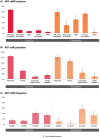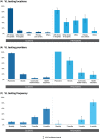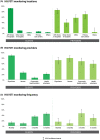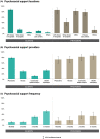Client and provider preferences for HIV care: Implications for implementing differentiated service delivery in Thailand
- PMID: 33792192
- PMCID: PMC8013790
- DOI: 10.1002/jia2.25693
Client and provider preferences for HIV care: Implications for implementing differentiated service delivery in Thailand
Abstract
Introduction: Differentiated service delivery (DSD) for antiretroviral therapy (ART) maintenance embodies the client-centred approach to tailor services to support people living with HIV in adhering to treatment and achieving viral suppression. We aimed to assess the preferences for HIV care and attitudes towards DSD for ART maintenance among ART clients and providers at healthcare facilities in Thailand.
Methods: A cross-sectional study using self-administered questionnaires was conducted in September-November 2018 at five healthcare facilities in four high HIV burden provinces in Thailand. Eligible participants who were ART clients aged ≥18 years and ART providers were recruited by consecutive sampling. Descriptive statistics were used to summarize demographic characteristics, preferences for HIV services and expectations and concerns towards DSD for ART maintenance.
Results: Five hundred clients and 52 providers completed the questionnaires. Their median ages (interquartile range; IQR) were 38.6 (29.8 to 45.5) and 37.3 (27.3 to 45.1); 48.5% and 78.9% were females, 16.8% and 1.9% were men who have sex with men, and 2.4% and 7.7% were transgender women, respectively. Most clients and providers agreed that ART maintenance tasks, including ART refill, viral load testing, HIV/sexually transmitted infection monitoring, and psychosocial support should be provided at ART clinics (85.2% to 90.8% vs. 76.9% to 84.6%), by physicians (77.0% to 94.6% vs. 71.2% to 100.0%), every three months (26.7% to 40.8% vs. 17.3% to 55.8%) or six months (33.0% to 56.7% vs. 28.9% to 80.8%). Clients agreed that DSD would encourage their autonomy (84.9%) and empower responsibility for their health (87.7%). Some clients and providers disagreed that DSD would lead to poor ART retention (54.0% vs. 40.4%), increased loss to follow-up (52.5% vs. 42.3%), and delayed detection of treatment failure (48.3% vs. 44.2%), whereas 31.4% to 50.0% of providers were unsure about these expectations and concerns.
Conclusions: Physician-led, facility-based clinical consultation visit spacing in combination with multi-month ART refill was identified as one promising DSD model in Thailand. However, low preference for decentralization and task shifting may prove challenging to implement other models, especially since many providers were unsure about DSD benefits. This calls for local implementation studies to prove feasibility and governmental and social support to legitimize and normalize DSD in order to gain acceptance among clients and providers.
Keywords: Thailand; antiretroviral therapy; differentiated service delivery; multi-month dispensing; people living with HIV.
© 2021 The Authors. Journal of the International AIDS Society published by John Wiley & Sons Ltd on behalf of the International AIDS Society.
Figures





References
-
- Fast‐track ending the AIDS epidemic by 2030. Joint United Nations Programme on HIV/AIDS; 2014.
-
- UNAIDS Data 2020. 2020.
-
- Thailand National Guidelines on HIV/AIDS Treatment and Prevention 2017. Bureau of AIDS, TB, and STIs, Department of Disease Control, Ministry of Public Health; 2017.
-
- Seekaew P, Amatavete S, Teeratakulpisarn N, Leenasirimakul P, Khusuwan S, Mathajittiphan P, et al. Same‐day antiretroviral therapy initiation in Thailand: Different models and initial outcomes from scale‐up in five provinces in Thailand. International AIDS Society Conference on HIV Science; Mexico City, Mexico; 2019.
Publication types
MeSH terms
Substances
Grants and funding
LinkOut - more resources
Full Text Sources
Other Literature Sources
Medical

